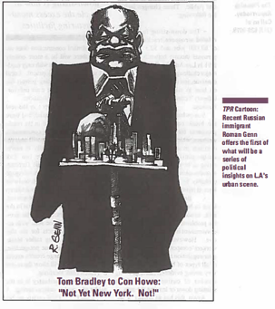This month, Con Howe, the former Executive Director of the New York City Planning Commission, is assuming his duties as Planning Director for the City of Los Angeles.
For the second of The Planning Report's open letters to new Los Angeles Planning Director Con Howe. TPR features the thoughts of Bill Christopher. Read the first open letter here.
Christopher serves as coordinator of PLAN/LA, a citywide coalition of neighborhood associations. He is an architect with Archaederral/Hong/Treiman, a former member of the Los Angeles Planning Commission and a current member of the Board of Zoning Appeals.
Dear Mr. Howe:
Welcome to L.A.
This is a city of contradictions, as you will soon learn. Your car phone will prove to be invaluable, but you will not have any responsibility for analyzing traffic impacts. You will learn all about housekeeping, but you will have no say in transportation planning. You will learn about liquor licenses, but you will have no say in siting schools.
You will be expected to deal in terms of growth management, but you will have nothing to do with redevelopment. You will see evidence of a housing crisis, but others will direct the housing policy. You will hear about the Warner Ridge decision, but you will have had no input into the court settlement.
In short, you will be expected to save the city, but will be given few of the necessary resources to approach the task in any rational manner.
Jobs vs. Trees
You are arriving in Los Angeles at a time when growth and economic realities are colliding with the underlying need to protect the sensitive environment. This unique set of circumstances is producing a serious debate between those whose mission is to house the population and keep the workforce employed versus those who would defend the lifestyle and landscape that has made Los Angeles an immigration mecca over the past decades. And the fun is just beginning.
Costs are being compared, and timelines analyzed to see where they impact on the ability to construct affordable housing, with less and less regard for the quality of life in all sectors of the economy. Open space, as an issue of necessity, has fallen by the wayside.
In spite of those pressures, we must not lose sight of the need to protect and enhance the neighborhoods where people live. And we must maintain a basic environmental accountability while promoting interaction between businesses and the communities they serve. We must act to assure that there will, in fact, be a livable city here that can house our children and their children.
The critical thing to understand about that approach is that it plays exactly the same way in Watts as it does in Bel-Air, in Baldwin Hills and in Sylmar, in Highland Park and in Canoga Park. The needs and desires of people are not at odds in the far-flung communities of this city, only focused on disparate questions. The residents of South Central are entitled to, and should be demanding, the same protections afforded to West Los Angeles.
Property Rights vs. Design Review
One has only to drive (a fascinating local custom) this city to see that we have been neglecting our cityscape and abdicating our responsibility to look after the feet of the urban form. From the condition of the street trees to the proliferation of billboards, there is a missing feeling of order and a lack of urban clarity throughout the city that can only be graciously called eclectic.
Unfortunately, that is exactly what the present regulations of the city promote. Projects, for the most part, are allowed to proceed with little public comment or input on the quality of design and its impact on the surrounding community.
What we have, as a result, is not a “Centers Concept” by any stretch of the imagination. What we have is only a partial dam base. Only when we understand what that data base represents can we attempt to regulate the growth elements of the future. And only then can we rationally assess the cost of housing the future population as a function of protecting the future livability of our city.
A New Landscape
That future falls to you Mr. Howe. You are now the only person with the responsibility to view the future of this city as a whole, with all communities and interest groups receiving equal and fair treatment. The Mayor and the Planning Commission are the only others who come close to you in that responsibility.
The Mayor has a few more immediate concerns that vie for his attention and the Commission is, at best, a part-time function that can only deal with individual issues as they arise. You, on the other hand, must be the one who is cognizant of the forces around you, while leading us all to the promised land. You are the one positioned to define the panorama and we are counting on you to paint a landscape that will endure, in a variety of hues that captures the energy and vitality of our communities.
A constituency for planning and design is emerging in this city. It will be up to you to nurture and cultivate that interest, molding it into a force to be reckoned with, and not let it be overwhelmed by those who would undermine it in the name of shortsighted goals.
As I have said in the past, every planner we lose in the budget wars will result in the need for two cops in future years; more people in policymaking roles need to understand this basic truth about city life.
Finally, to paraphrase Carey McWilliams, Los Angeles remains an exploding volcano of people and projects, and you now have a ringside seat at the circus. Welcome aboard.
Bill Christopher
- Log in to post comments




